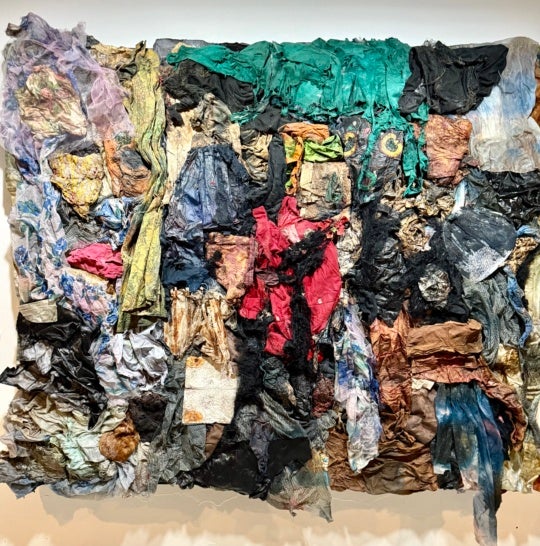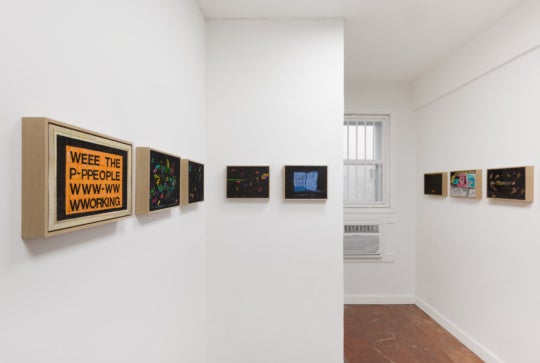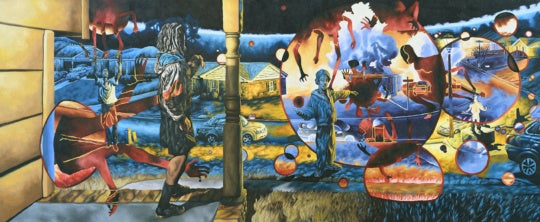
Tilden and the Theban Hero, on view at Emory University’s Visual Arts Gallery until December 14, is the latest in a series of deftly prepared installations by Andrew Scott Ross. Working primarily with painstakingly cut paper, the artist uses a modest material to explore a mammoth theme: the intersection of histories both ancient and individual. Ross’s practice freely intertwines images and narrative arcs from ancient history and classical mythology with those of his own family history. According to the press release the show “combines threads of Greek mythology with the artist’s own familial history to form more intimate relationships with both.”
In shifting focus from one epoch to another, Ross alters the handling of his materials accordingly. My Century Zoo (2011), which focused on the Neolithic Age, used mud, paper, and wood to create a work whose expressionistic tenor reflected the rough upheavals and developments of that period. In Tilden and the Theban Hero, Ross turns his eye toward the ordered worlds of ancient Greece and Rome. True to form, he trades in My Century Zoo’s mud-spattered busts in favor of clean black paper and rectilinear white landmasses.

The work on display, which takes the form of a raised stage and sits in the center of the space, differs structurally from Ross’s previous works. Whereas Rocks and Caves (2006) functioned as an immersive installation that invited the viewer into intimate proximity with the fragile works, Stones and Rocks and Stones and Bones (2009) more closely resembled a natural history diorama, complete with rope barrier and set into a wall. Tilden, however, takes the stage as its main structural element. Perhaps harking back to the ancient Greek Dionysia, festivals in which plays were performed to honor Dionysus, the present work comprises various discrete stages on which fragments of narratives are acted out.
Individual tableaus, while formally delightful, provide few clues as to the rules of this fictional civilization. On one stage a man battles a menacing, oversized crab while several steps away two men seem weirdly unconcerned by an identical beast. To the left of another stage two treasure-bearing pedestals drift into the ocean. In a world whose inhabitants take great care in selecting and showcasing objects of importance, the release of two such treasures would seem significant. One wonders if they are offerings to the gods who preside over the untame ocean or represent the inevitable drift of artifacts and their accompanying stories from the realm of history into mythology. The moment remains a mystery as it is the only one of its kind in the entire work. Such moments tantalize but ultimately their opacity denies the viewer entry into the work on a deeper level. Similarly, the artist’s familial history manifests through mildly incongruous elements in the landscape. Diamonds make an appearance, presumably as a reference to Ross’s family’s extensive involvement in the jewelry industry. Without this knowledge, however, such elements remain mysterious. In the absence of emergent patterns I am confronted rather than immersed. The world that I encounter, while dazzling in scope and detail, remains strange and impenetrable.

There are, however, instances in which ambiguity proves more fruitful than frustrating. Hovering above the landscape is a loose cloud of animals, men, animal-men, archaeological fragments, and mythological vignettes. Here the suppleness of Ross’s signature paper cutouts are elegantly appropriate. Strings of these gently bent forms connect heaven and earth, though it is unclear whether they are ascending into a dream world of man’s imagining or descending to permeate the phenomenal world. This fluidity of exchange between Earth and the heavens suggests a sort of leveling of historical and mythical landscapes.
Although the work contains autobiographical elements, their quiet integration into it effectively forfeits personal narrative as a pertinent theme. In its place, the permeable boundary between history and myth emerges as the most compelling theme and the one most skillfully expressed by formal means. Tilden and the Theban Hero demonstrates the way in which history, with its unmanageable depth and density, is inevitably fragmented and floated into individual consciousness like ancient myths half-heard yet fully felt.




